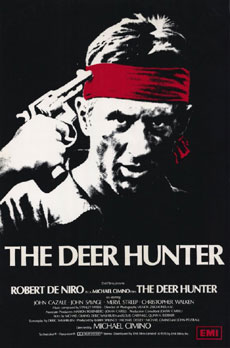The film is split into three main sections. The first establishes their
lives in the steel community. The guys work hard at the steel mill during
the day and relax by shooting pool in a bar, singing along to the pop
songs, or by taking weekend journeys into the woods to go hunting. Of
this group, the only one who really cares if he shoots something is
Michael (De Niro), who takes hunting seriously, insisting it should
only take one shot to kill a deer.
The friends get ready for the wedding of Steven (John Savage), and
there are long scenes of them preparing, joshing around, participating
in the ceremony, and dancing at the reception to Russian folk music.
Meanwhile, four of the guys — Michael, Steven, Nick (Walken) and
Axel (Chuck Aspegren) — are about to ship out to the military for
basic training for Vietnam. So the reception doubles as a farewell party.
The second section takes place in Vietnam, opening with Michael, Steven
and Nick facing the psychologically-damaging realities of a POW camp.
Michael's strength is the only thing that keeps Steven and Nick going,
despite the cruelties of their captors.
A final section takes place after the war. Having been discharged from
the military, the friends have gone their separate ways, with Axel and
Michael returning home. But seeing how much their absence is hurting
their loved ones — such as Nick's fiancee, Linda — Michael
uses his hunter's instincts to track down Steven and Nick and try to
convince them to come home.
The hardest scenes to watch are the scenes of Russian roulette. Of
course, those scenes are the centerpiece of the film, and are frequently
referred to in pop culture. Initially, this brutal game is forced upon
the men in a POW camp. Then, later, it becomes a symbol for hopelessness
and desperation. These scenes take viewers out of their comfort zone.
In this modern age, we are used to war films, to scenes of people getting
shot. But to watch somebody put a gun to their own head and pull the
trigger, that produces a sort of unease that cannot be underestimated
and helps to bring home the terrible realities of war.
Russian roulette serves as a metaphor for the men's experiences. Whether
they were drafted or volunteered, once they entered the military, they
had no control. Instead, their wartime experiences were a matter of
playing the odds: while many soldiers survived, some were not so lucky.
And yet, they must keep going.
The version of the movie I watched did not come with a making-of documentary,
but it did include production notes, which I read through. According
to Cimino, it didn't matter whether it was a war or some other big event
in their lives; this was a movie about testing people's strength. Obviously,
Michael, the deer hunter of the title, is the one who has the mental
fortitude to make it, while his other friends experience various problems
as a result.
It's interesting to note that Savage and De Niro did their own stunts
for a scene where they grab onto a helicopter's runners. De Niro, known
for taking his roles seriously, studied for his part by socializing
with actual steelworkers. Coincidentally, Aspergen was not an actor
when he was cast, but rather the foreman at a steel works visited by
De Niro and Cimino. They were so impressed with him, they offered him
the role.
Sadly, Cazale, who also appeared with De Niro in The Godfather II,
was terminally ill during the making of the film and died of cancer
shortly after filming was completed.
The fact that this film came out in 1978, five years after the last
American troops left the country, makes this film easy to read as social
commentary. Like other Oscar-winning post-war films (The Best Years
of Our Lives, The Bridge on the River Kwai), the film asks us to
consider the pointlessness of war and the impact on the men who fight
it. The movie was inspired in part by actual news footage of the war.
After viewing it, Vietnam veteran Jan Scruggs, a counselor with the
U.S. Department of Labor, was inspired to build a National Memorial
for Vietnam Veterans and began operating the memorial fund that eventually
paid for it.
Despite the suspense-filled Russian roulette scenes, most of The
Deer Hunter is fairly forgettable: slow-paced, with little dialogue.
The cinematography is rather passive: showing lots of wide shots and
rarely focusing attention on the details that might have helped us understand
these characters better. A sprawling film, with too many characters,
only a few of which are drawn with any vividness, the film is front-loaded
with exposition.
That doesn't mean it's a bad movie. Sometimes movies that are difficult
to watch are still important, because of the statements they make. And
of course, De Niro, the heart of the film, is worth watching, as is
Walken, in his first major role.


